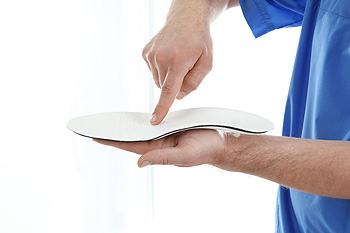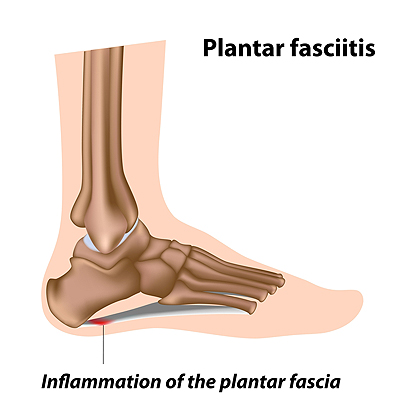
 Those suffering from painful conditions such as plantar fasciitis can find relief with orthotics, or shoe inserts. Orthotics can help minimize symptoms of pain and stiffness in the heel. These symptoms typically occur as a result of stress on the plantar fascia due to standing or walking. Orthotics can reduce these symptoms by contouring to the shape of the foot and providing cushion. This extra cushion absorbs excess shock experienced when walking and reduces the pressure on the heel. While standard versions are available, orthotics can also be custom-made to fit the feet for optimal results. If you have questions about orthotics and if they can work for you, consult with your podiatrist.
Those suffering from painful conditions such as plantar fasciitis can find relief with orthotics, or shoe inserts. Orthotics can help minimize symptoms of pain and stiffness in the heel. These symptoms typically occur as a result of stress on the plantar fascia due to standing or walking. Orthotics can reduce these symptoms by contouring to the shape of the foot and providing cushion. This extra cushion absorbs excess shock experienced when walking and reduces the pressure on the heel. While standard versions are available, orthotics can also be custom-made to fit the feet for optimal results. If you have questions about orthotics and if they can work for you, consult with your podiatrist.
If you are having discomfort in your feet and would like to try orthotics, contact Dr. Lubrina Bryant from District Podiatry, PLLC. Our doctor can provide the care you need to keep you pain-free and on your feet.
What Are Orthotics?
Orthotics are inserts you can place into your shoes to help with a variety of foot problems such as flat feet or foot pain. Orthotics provide relief and comfort for minor foot and heel pain but can’t correct serious biomechanical problems in your feet.
Over-the-Counter Inserts
Orthotics come in a wide variety of over-the-counter inserts that are used to treat foot pain, heel pain, and minor problems. For example, arch supports can be inserted into your shoes to help correct overarched or flat feet, while gel insoles are often used because they provide comfort and relief from foot and heel pain by alleviating pressure.
Prescription Orthotics
If over-the-counter inserts don’t work for you or if you have a more severe foot concern, it is possible to have your podiatrist prescribe custom orthotics. These high-quality inserts are designed to treat problems such as abnormal motion, plantar fasciitis, and severe forms of heel pain. They can even be used to help patients suffering from diabetes by treating foot ulcers and painful calluses and are usually molded to your feet individually, which allows them to provide full support and comfort.
If you are experiencing minor to severe foot or heel pain, it’s recommended to speak with your podiatrist about the possibilities of using orthotics. A podiatrist can determine which type of orthotic is right for you and allow you to take the first steps towards being pain-free.
If you have any questions please contact our office located in Washington, D.C . We offer the newest diagnostic and treatment technologies for all your foot and ankle needs.
Orthotics are shoe inserts that are meant to correct an irregular walking gait or provide cushioning to the feet. Orthotics come in a variety of different models and sizes, including over-the-counter and customizable variants. Customizable orthotics can be shaped and contoured to fit inside a specific shoe and are typically prescribed through a podiatrist who specializes in customized footwear and orthotics design and management.
Orthotics are beneficial because they can help prevent injuries from occurring and provide cushioning to keep pain levels down to a minimum. They also allow for the correct positioning of the feet. Orthotics can act as shock absorbers to help remove pressure from the foot and ankle. Therefore, orthotics can make bodily movements, such as walking and running, become more comfortable as well as help prevent the development of certain foot conditions.
Orthotics alleviate pain and make the foot more comfortable by slightly altering the angle at which the foot strikes the ground surface, therefore controlling the movement of the foot and ankle. Orthotics come in different variants and can be made of various materials. To determine what type of orthotic is most suited to your feet and your needs, it is best to consult your podiatrist. He or she will be able to recommend a type of orthotic that can help improve your foot function or prescribe a custom orthotic to best fit your feet.
 Research has indicated when children's feet receive proper care, potential foot problems that can develop as adults may diminish. When children get into the habit of washing and drying their feet on a daily basis, foot conditions, including athlete’s foot, may be prevented. Children’s feet will benefit from walking barefoot while indoors. This helps the toes to become strong by grasping the floor. When it is time to walk outdoors, it is important to have your child’s feet properly measured. This can help to determine the correct size shoe to ensure comfortable walking. The unpleasant foot condition, known as ingrown toenails, may be prevented when the toenails are trimmed straight across the toe. Please consult with a podiatrist if you would like additional information about foot care for children.
Research has indicated when children's feet receive proper care, potential foot problems that can develop as adults may diminish. When children get into the habit of washing and drying their feet on a daily basis, foot conditions, including athlete’s foot, may be prevented. Children’s feet will benefit from walking barefoot while indoors. This helps the toes to become strong by grasping the floor. When it is time to walk outdoors, it is important to have your child’s feet properly measured. This can help to determine the correct size shoe to ensure comfortable walking. The unpleasant foot condition, known as ingrown toenails, may be prevented when the toenails are trimmed straight across the toe. Please consult with a podiatrist if you would like additional information about foot care for children.
Making sure that your children maintain good foot health is very important as they grow. If you have any questions, contact Dr. Lubrina Bryant of District Podiatry, PLLC. Our doctor can provide the care you need to keep you pain-free and on your feet.
Keeping Children's Feet Healthy
Having healthy feet during childhood can help prevent medical problems later in life, namely in the back and legs. As children grow, their feet require different types of care. Here are some things to consider...
Although babies do not walk yet, it is still very important to take care of their feet.
Avoid putting tight shoes or socks on his or her feet.
Allow the baby to stretch and kick his or her feet to feel comfortable.
As a toddler, kids are now on the move and begin to develop differently. At this age, toddlers are getting a feel for walking, so don’t be alarmed if your toddler is unsteady or ‘walks funny’.
As your child gets older, it is important to teach them how to take care of their feet.
Show them proper hygiene to prevent infections such as fungus.
Be watchful for any pain or injury.
Have all injuries checked by a doctor as soon as possible.
Comfortable, protective shoes should always be worn, especially at play.
If you have any questions please feel free to contact our office located in Washington, D.C . We offer the newest diagnostic and treatment technologies for all your foot and ankle needs.
Being a parent involves caring for your child in every way you can. You make sure they are eating the right food, being nice to others, and staying out of any trouble. However, it is also important that you are watchful of their health, more specifically their foot health. Maintaining good foot health in childhood is important in preventing later conditions in life from happening. As children continue to develop, their feet require different techniques of care. Here are some various ways in which you can help your child’s feet stay healthy.
A baby needs a lot of care and attention overall, but the importance of their feet should never be forgotten. Before a baby turns one, their feet change and develop greatly. It is important that during this time, a mother avoids putting tight socks on their child. She should also encourage movement of their feet so the baby can begin to feel more comfortable using them.
As a baby enters the toddler years of his or her life, they are begin to walk around. When your baby begins to take those first steps, it is crucial that they are wearing protective shoes on their feet. As a mother that is observant of your child’s feet, you may notice changes in them. This is completely normal as the feet are becoming susceptible to the activity of walking. It is normal for a toddler to be a bit unsteady or to “walk funny” at first.
When your child grows out of their toddler years, it is important that you begin to show him or her how to care for their feet on their own. Practice with your child proper hygiene in order to prevent foot fungus or infection. Since children are constantly on the move, it is crucial to be cautious of any accidents or injuries that might occur. If an injury occurs, it is advised that you take your child to be examined by a doctor immediately. Since your child is still growing, particular injuries can shift the way in which a bone or other important part of the foot is developing.
Babies and kids are always changing and growing. Your job as a parent is to make sure they stay healthy and making sure they are properly maintained. This involves proper foot care and making sure the feet stay healthy. Following this guide, your child can live a long and happy life.
 There is a portion of tissue that is located on the bottom of the foot. It is known as the plantar fascia, and it connects the heel to the toes. If an injury occurs, this band of tissue may become inflamed, and a condition that is referred to as plantar fasciitis may develop. The pain and discomfort that is associated with this ailment is often felt in the heel and surrounding areas. Many patients experience severe pain in the morning upon arising, and the heel may be swollen and stiff. This condition can happen as a result of standing for extended periods of time throughout the day, rapidly gaining weight, or wearing shoes that do not fit correctly. Moderate relief can be felt when the foot is resting, and it may be beneficial to practice specific stretching techniques that can help to strengthen the plantar fascia. If you are afflicted with plantar fasciitis, it is strongly suggested that you consult with a podiatrist who can properly treat this condition.
There is a portion of tissue that is located on the bottom of the foot. It is known as the plantar fascia, and it connects the heel to the toes. If an injury occurs, this band of tissue may become inflamed, and a condition that is referred to as plantar fasciitis may develop. The pain and discomfort that is associated with this ailment is often felt in the heel and surrounding areas. Many patients experience severe pain in the morning upon arising, and the heel may be swollen and stiff. This condition can happen as a result of standing for extended periods of time throughout the day, rapidly gaining weight, or wearing shoes that do not fit correctly. Moderate relief can be felt when the foot is resting, and it may be beneficial to practice specific stretching techniques that can help to strengthen the plantar fascia. If you are afflicted with plantar fasciitis, it is strongly suggested that you consult with a podiatrist who can properly treat this condition.
Plantar fasciitis can be very painful and inconvenient. If you are experiencing heel pain or symptoms of plantar fasciitis, contact Dr. Lubrina Bryant from District Podiatry, PLLC. Our doctor can provide the care you need to keep you pain-free and on your feet.
What Is Plantar Fasciitis?
Plantar fasciitis is the inflammation of the thick band of tissue that runs along the bottom of your foot, known as the plantar fascia, and causes mild to severe heel pain.
What Causes Plantar Fasciitis?
How Can It Be Treated?
While very treatable, plantar fasciitis is definitely not something that should be ignored. Especially in severe cases, speaking to your doctor right away is highly recommended to avoid complications and severe heel pain. Your podiatrist can work with you to provide the appropriate treatment options tailored to your condition.
If you have any questions please feel free to contact our office located in Washington, D.C . We offer the newest diagnostic and treatment technologies for all your foot and ankle needs.
Plantar fasciitis is one of the most common causes of heel pain. The plantar fascia is the thick band of tissue that connects the heel bone to the toes. When this band of connective tissue becomes inflamed, plantar fasciitis occurs. Fortunately, this condition is treatable.
There are several factors that may put you at a greater risk for developing plantar fasciitis. One of the biggest factors is age; plantar fasciitis is common in those between the ages of 40 to 60. People who have jobs that require them to be on their feet are also likely to develop plantar fasciitis. This includes factory workers, teachers, and others who spend a large portion of their day walking around on hard surfaces. Another risk factor is obesity because excess weight can result in extra stress being placed on the plantar fascia.
People with plantar fasciitis often experience a stabbing pain in the heel area. This pain is usually at its worst in the morning, but can also be triggered by periods of standing or sitting. Plantar fasciitis may make it hard to run and walk. It may also make the foot feel stiff and sensitive, which consequently makes walking barefoot difficult.
Treatment for plantar fasciitis depends on the severity of the specific case of the condition. Ice massage applications may be used to reduce pain and inflammation. Physical therapy is often used to treat plantar fasciitis, and this may include stretching exercises. Another treatment option is anti-inflammatory medication, such as ibuprofen.
If you suspect that you have plantar fasciitis, meet with your podiatrist immediately. If left untreated, symptoms may lead to tearing and overstretching of the plantar fascia. The solution is early detection and treatment. Be sure to speak with your podiatrist if you are experiencing heel pain.
 An injury that majority of runners fear is known as a stress fracture. It is typically caused by frequent running or jogging without properly warming up and stretching the lower legs and feet. It often occurs when the intensity of the workout is increased too quickly. The symptoms that many patients experience include stiffness in the affected area and sore muscles. Additionally, swelling may be noticed on top of the foot, and this can be a result of a stress fracture. The pain may be severe, and it may cause the patient to walk with a different gait. If you are experiencing these types of symptoms, it is advised that you seek the counsel of a podiatrist who can properly diagnosis this condition and offer the best treatment plan for you.
An injury that majority of runners fear is known as a stress fracture. It is typically caused by frequent running or jogging without properly warming up and stretching the lower legs and feet. It often occurs when the intensity of the workout is increased too quickly. The symptoms that many patients experience include stiffness in the affected area and sore muscles. Additionally, swelling may be noticed on top of the foot, and this can be a result of a stress fracture. The pain may be severe, and it may cause the patient to walk with a different gait. If you are experiencing these types of symptoms, it is advised that you seek the counsel of a podiatrist who can properly diagnosis this condition and offer the best treatment plan for you.
Stress fractures occur when there is a tiny crack within a bone. To learn more, contact Dr. Lubrina Bryant from District Podiatry, PLLC. Our doctor can provide the care you need to keep you pain free and on your feet.
How Are They Caused?
Stress fractures are the result of repetitive force being placed on the bone. Since the lower leg and feet often carry most of the body’s weight, stress fractures are likely to occur in these areas. If you rush into a new exercise, you are more likely to develop a stress fracture since you are starting too much, too soon. Pain resulting from stress fractures may go unnoticed at first, however it may start to worsen over time.
Risk Factors
Stress fractures do not always heal properly, so it is important that you seek help from a podiatrist if you suspect you may have one. Ignoring your stress fracture may cause it to worsen, and you may develop chronic pain as well as additional fractures.
If you have any questions, please feel free to contact our office located in Washington, D.C . We offer the newest diagnostic and treatment technologies for all your foot care needs.
Our bones are important aspects of our body and they are constantly changing. The heavier the workload for a bone, the more likely it is that calcium will be placed in it. When a bone isn’t used often, there won’t be much calcium within it. When stress from repetitive loads prevent the bone from being able to repair itself, cracks will start to form. Stress fractures are defined as cracks in a bone that result from repetitive force, such as overuse.
The most common cause of stress fractures is a sudden increase in intensity and duration of physical activity. For example, if you begin to run long distances without working your way into doing so, you will be more likely to develop a stress fracture.
Common symptoms of stress fractures are pain and swelling near the weight bearing area on the injured bone. When initial x-rays are performed, it is possible that the fracture will not show up. However, once the stress on the area continues, the damage will increase, and the fracture will be severe enough to show up on an x-ray. Certain parts of the foot are more likely to develop stress fractures than others. Areas that typically have these fractures are: the metatarsals, the navicular bone, the calcaneus, tibia, and fibula.
Since women are at an increased risk of developing osteoporosis, they are twice as likely as men to sustain a stress fracture. Additionally, old age causes a decrease in bone mineral density which is why elderly people are also likely to develop these fractures.
It is important for you to be professionally diagnosed by a podiatrist if you suspect you have a stress fracture, because there are other injuries that can easily be mistaken for a fracture. Sprains, strains, shin splints, plantar fasciitis, and Morton’s neuroma can all easily be mistaken for stress fractures in the foot. Your podiatrist will likely ask you a series of questions to determine what type of pain you are experiencing. These questions will help your doctor identify whether you have a stress fracture.
The best method of treatment for a stress fracture is rest. Additionally, a walking boot, cast, or crutches, will help rest the area that is injured. The typical healing time for stress fractures is 4-12 weeks, however this depends on which bone is involved.